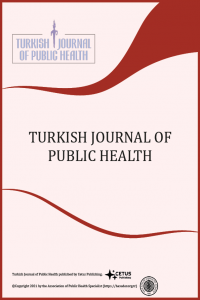İzmir İli Güzelbahçe İlçesi’nde ilköğretim öğrencilerinde obezite prevalansı ve beslenme alışkanlıklarının belirlenmesi
Amaç: Güzelbahçe’de ilköğretim birinci kademe öğrencilerin obezite prevalansının, beslenme alışkanlıklarının ve velilerin “Beslenme Dostu Okul Projesi” hakkında düşüncelerinin saptanmasıdır. Yöntem: Kesitsel tipte bir araştırmadır. Araştırmaya Güzelbahçe’deki birinci kademede eğitim gören 549 kişi alındı. Araştırma iki devlet, iki özel okulda Mart-Mayıs 2012 tarihleri arasında yapıldı. 549 kişiye ulaşıldı. Araştırmanın bağımlı değişkeni beden kitle indeksine (BKİ) göre belirlenen obezite durumudur. Bağımsız değişkenler; sosyo demografik özellikler, okul türü, beslenme alışkanlıkları, fiziksel aktivite, TV ve bilgisayar kullanımı ve besin tüketim sıklığıdır. Araştırmada öğrenci velilerine ve öğrencilere, tükettikleri besinlerle ilgili anket uygulandı. Öğrencilerin boy ve kiloları ölçülerek BKİ hesaplandı. Çözümlemede ki-kare analizi ve lojistik regresyon kullanıldı. Obeziteye neden olan etmenler için OR hesaplandı. Bulgular: Araştırma grubunda obezite prevalansı %20’dir. Erkeklerde kızlara göre 1.79 kat obezite daha fazladır. Annenin eğitimi arttıkça obezite anlamlı olarak artmıştır. Okul türü ve beslenme alışkanlıkları arasında anlamlı bir ilişki yoktur. Öğrencilerin kantinden en çok tükettiği yiyecekler; çikolata, patates kızartması ve gevrektir. En çok tükettikleri içecekler ise süt, ayran ve meyve suyudur. Velilerin %95.9’u projeyi desteklerken %88.1’i proje sayesinde obezitenin azalacağını düşünmektedir. Sonuç: Çalışmada anne eğitiminin yüksek olması, aylık gelirin yüksek olması obeziteyi arttırmaktadır. Velilere beslenme ve sağlıklı yiyecek hazırlama ile ilgili eğitim verilebilir. Çocuklarda fiziksel aktivite arttırılmalıdır.
Anahtar Kelimeler:
Obezite, BKİ, Beslenme Alışkanlıkları, Beslenme Dostu Okul Projesi
Determining the prevalence of obesity in primary school students and eating habits in Izmir
Objective: This study examined the prevalance of obesity in primary school students in Güzelbahçe, eating habits and parents’ opinion about “Nutrition-Friendly School Project”. Methods: This is a cross-sectional study. 549 children are taken to the study having education in primary schools in Güzelbahçe. Study was conducted in two public and two private schools between March-May 2012 in Güzelbahçe. We reached 549 students. The dependent variable is obesity conditions determined according to BMI. The independent variables are socio-demographic attributes, kind of school, food habits, physical activity, watching TV and computer usage and frequency of food consumption. In the research, a questionnaire was applied to student’s parents in relation with independent variables and applied to students in relation with the food consumption. Height and weight of students were measured and BMI was calculated. Chi-square analysis and logistic regression were used for statistical analysis. OR’s were calculated for factors that cause obesity. Results: Prevalence of obesity was 20% in the study. There is a significant higher obesity in boys than girls. Prevalence of obesity was significantly higher in higher education of mothers. There is no significant relationship between school type and eating habits and obesity. Most consumed food from the canteen by student; chocolate, fries and cornflakes. Most consumed drinks are milk,ayran and fruit juice. Parents of support this project 95.9% and most parents think that there will be a decrease in obesity for Project 89.1%. Conclusions: Higher education of mothers and higher monthly income is associated with obesity of children. Mothers can be given education about nutrition at home and healthy food preparation. Physical activity in children should be increased.
- Başlangıç: 2003
- Yayıncı: Halk Sağlığı Uzmanları Derneği
Sayıdaki Diğer Makaleler
Türkiye’de Halk Sağlığı Uzmanları İçin İnsangücü Planlaması (2013-2023)
Bülent Kılıç, Ceyda Şahan, Hande Bahadır
Evaluation of health services: A directive for public health professionals
Saurabh Shrivastava, Prateek Shrivastava, Jegadeesh Ramasamy
Yaşlılarda sağlık hizmetlerine ve sosyal hizmetlere erişim sorunları
Fazla kilolu ve obez kadınlarda fiziksel aktivite programı girişimi
Öznur Özkan Bambal, Pınar Erbay Dündar, Gürkan Er, Özgür Bayturan
Kevser Tarı Selçuk, Melih Sözmen, Belgin Ünal
Türkiye’de kalp ve damar hastalıkları sıklıklarındaki değişimin değerlendirilmesi
